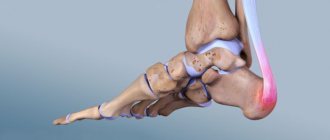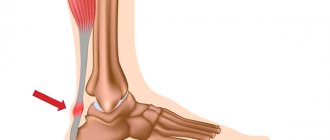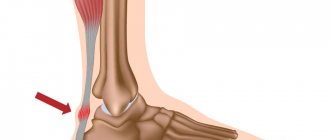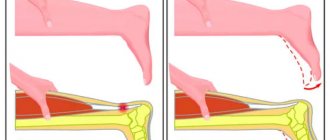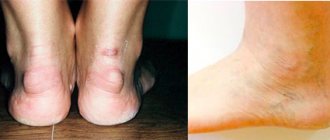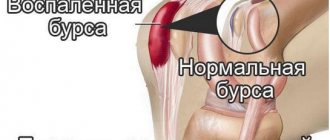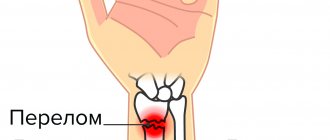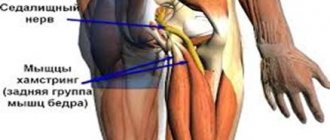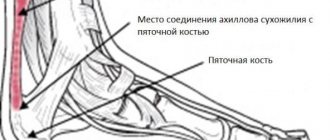- Treatment of Achilles tendon diseases
- Conservative treatment of Achilles tendon diseases
- Treatment of Achilles tendon diseases using shock wave therapy
- How is the treatment of Achilles tendon diseases performed?
- Side effects in the treatment of Achilles tendon diseases
- Achilles tendon diseases: general information
- Methods of conservative treatment of Achilles tendon diseases
- SWT in the treatment of Achilles tendon diseases: a review of scientific literature
- Conclusion
Treatment of Achilles tendon diseases in our clinic
Our clinic has been successfully treating Achilles tendon diseases for quite a long time, using an integrated approach. Diseases of the Achilles tendon most often occur, as a rule, among athletes and outdoor enthusiasts. As a result of frequent or excessive load, it becomes injured, areas of sprains or micro-tears appear, and local inflammation develops. A tendon injury is accompanied by aching pain in the lower third of the leg along the back surface. In the initial stage of the process, pain only bothers you after exercise. If left untreated, the pain syndrome is constantly present, swelling and stiffness in the ankle joint develop. Achilles tendon diseases: achillodynia - pain in the Achilles tendon, achilles - inflammation of the tendon and achillobursitis - inflammation of the synovial bursa around the tendon.
special instructions
When prescribing treatment methods, you need to focus on the symptoms of tendon inflammation.
In practice, doctors often prescribe injections of powerful anti-inflammatory drugs such as cortisone to patients. It is injected into the area of the diseased tendon. At the same time, non-steroidal drugs are prescribed. Cortisone can suppress inflammation, but can also cause tissue damage, even rupture. Considering poor blood circulation in the diseased organ, anti-inflammatory pills are also not always harmless, as they can cause a number of adverse reactions.
Conservative treatment of Achilles tendon diseases
We use both classical conservative approaches in the treatment of Achilles tendon diseases, and we use the latest treatment methods. Conservative treatment includes restriction of physical activity, or complete immobilization - a plaster splint is applied. Physiotherapy will be added later. For achilles and achillobursitis, the course of treatment necessarily includes NSAIDs. Severe pain is often relieved by blockade with corticosteroid hormones. If conservative therapy is ineffective, surgical interventions are resorted to. However, even after surgery, pain may occur as a result of scar changes in the tissue.
The clinic has collected an impressive arsenal of methods for restorative treatment and relief of acute and chronic pain: various methods of physiotherapy, medical massage, manual techniques and exercise therapy, methods of regenerative medicine, various types of blockades are carried out, the “dry needle” method is used, medical botulinum therapy, pharmacotherapy.
Recently, we have successfully used the shock wave therapy method as one of the most effective methods as part of complex therapy.
Treatment of Achilles tendon diseases using shock wave therapy
In our clinic, focused and radial shock wave therapy is successfully used as part of the complex treatment of Achilles tendon diseases. According to numerous recent scientific publications and our practice, the UVT method has proven itself in treatment, giving good results compared to conservative methods.
A patient visiting our clinic for the first time undergoes an initial appointment with an orthopedist-traumatologist. The doctor will most likely need the results of an X-ray or MRI, a blood test, and an ultrasound examination. A course of UVT procedures is prescribed, usually from 5 to 10 procedures with an interval of 3 to 7 days.
The interval between procedures is individual and can be reduced if there are no side effects and the procedures are well tolerated. The duration of the procedure is from 20 to 40 minutes. (in some cases more).
Medicines
It is possible to alleviate the suffering of patients and reduce symptoms through the use of non-steroidal anti-inflammatory drugs, for example, aspirin or diclofenac. In some situations, to prevent recurrent inflammation, doctors prescribe the use of cortisone injections in combination with physiotherapy. If after ten days the patient does not experience any improvement, then you should immediately stop using this or that drug. It must be emphasized that under no circumstances should the above-mentioned remedies be used without a doctor’s prescription. We also must not forget that any self-medication often ends not in healing, but in the development of more serious complications of the disease.
How is the procedure for treating Achilles tendon diseases using the UVT method?
The procedure itself is performed in combination using focused and radial applicators. Radial shock wave is most often used at the beginning of the procedure. The radial wave is used not only when working with the tendon itself, but also with adjacent regions of the leg, since the pathological process often affects adjacent tissues. The radial applicator targets tissue at shallow depths and results in many beneficial long-term “tissue” effects (reduced inflammation, capillary sprouting, stem cell influx, etc.). These effects do not appear immediately, but after a fairly long period of time - from 3 weeks, and develop over several months, leading to deep tissue regeneration. The main effect of the shock wave is aimed at relieving pain and tightness, suppressing inflammation, accelerating tissue metabolism, and loosening the tissues of the affected areas.
After the radial wave, a focused wave is used, which penetrates deep into the tissue, reaching the area of pain, and causing a loosening and analgesic effect. Under the influence of shock waves, endothelial NO synthase (eNOS) is activated, and the production of endogenous nitric oxide is triggered in both normal and inflamed tissues. Activation of eNOS leads to relaxation of blood vessels and a reduction in spasticity, pain, inflammation and swelling. In addition, the loosening effect of shock waves is important, which indirectly affects the mechanical properties of affected and already changed tissues, softens the connective tissue of the tendon, and indirectly helps to increase the range of elastic stretching.
When using a focused wave, the doctor must find the place of greatest pain and aim the focal spot of shock waves at it from different angles, evenly treating the area of pain. The effect of the procedure depends on the experience and professionalism of the doctor. This results in decreased pain and increased range of motion after the first procedure. Thus, the effect of a focused wave is usually immediate and increases with each procedure, while the effect of a radial wave is delayed, noticeable from the 3rd week onwards. When performing procedures in our clinic, we sometimes allow moderate pain to occur during the procedure, which should be perceived as a good thing and a sign of the effectiveness of the procedure.
Achilles tendon diseases: general information
The Achilles tendon is the largest and most powerful tendon in the human body. In its thickness there are special cells (tenocytes). They produce elastin and collagen - components of the Achilles tendon fibers, the main function of which is to provide flexion of the foot and shock absorption during walking or running.
Rice. 1. Location of the Achilles tendon
During physical exercise, the load on the Achilles tendon can be up to 900 kg. In athletes and outdoor enthusiasts, as a result of frequent or excessive load, it becomes injured, areas of sprains or micro-tears appear, local inflammation develops and the need for a recovery period arises. If the rest after exercise is short, inflammation in the tissues intensifies, achillodynia (pain in the Achilles tendon) appears, as well as symptoms of achilles (inflammation of the tendon) and achillobursitis (inflammation of the synovial bursa around the tendon).
Risk factors that provoke the development of these diseases:
- Age-related changes. In people over 40 years of age, the regenerative capabilities of body tissues decrease. Accordingly, previously habitual physical activity can lead to an increased risk of tendon injury and the development of the processes described above.
- Sexual characteristics. In men, the incidence of this type of pathology is 6 times higher than in women. This is due to hormonal characteristics - female hormones increase the strength of the tendon-ligamentous apparatus.
- Excess weight.
- Foot deformities.
- Rheumatological diseases.
Rice. 2. Localization of achillobursitis
Diseases of the Achilles tendon are manifested by the following symptoms:
- Aching pain in the lower third of the leg along the back surface. In the initial stage of the process, pain only bothers you after exercise. Without treatment, pain is always present.
- The pain can be localized in the heel area and spread up to the lower leg.
- When plantar flexing the foot, the pain intensifies.
- Tissue swelling and thickening of the Achilles tendon.
- The skin in the area of the pathological process may be warm to the touch.
- Movement in the ankle joint is severely limited due to pain.
Diagnosis of Achilles tendon diseases is based on an analysis of complaints and an external examination. From instrumental studies, an ultrasound is performed to determine whether there is a rupture, hematomas, or fluid in the synovial bursa. X-ray or MRI is performed to identify calcifications in the tendon tissue.
Symptoms
Signs of tendon inflammation can appear suddenly or develop gradually, depending on the cause. The main symptoms of inflammation are:
- The presence of very painful sensations. They arise at the site of the lesion, but may have blurred boundaries. In this case, pain comes in different forms. It can manifest itself in the form of aching, cutting, stabbing manifestations, and radiate into the muscles.
- Feeling of stiffness in movements.
- Inability to bend the joint.
- The presence of swelling in the affected area.
- The presence of a feeling of discomfort.
- The appearance of various sounds when the joints move.
- Presence of redness.
- Increased body temperature.
- The process of deformation in the joint area.
Some signs of inflammation of the tendon in the hand may indicate the presence of a chronic form of tendinitis. It causes a lot of trouble, interfering with a person’s full life. In such a situation, you need to urgently consult a doctor to undergo examination and begin treatment. Any inflammation can significantly limit a person’s movements, and self-medication often ends in bad consequences.
Methods of conservative treatment of Achilles tendon diseases
We use both classical conservative approaches in the treatment of Achilles tendon diseases, and we use the latest treatment methods. Conservative treatment measures for Achillitis and tendon injuries begin with restriction of physical activity or complete immobilization - a plaster splint is applied. Physiotherapy will be added later. For achilles and achillobursitis, the course of treatment necessarily includes NSAIDs. Severe pain is relieved by blockade with corticosteroid hormones. During the recovery period, patients are recommended to wear orthopedic insoles. If conservative therapy is ineffective, surgical interventions are resorted to. However, even after surgery, pain may occur as a result of scar changes in the tissue. The lack of effectiveness of various areas of treatment for Achilles tendon diseases forces doctors to look for new therapeutic methods. In our clinic, focused and radial shock wave therapy is successfully used as part of the complex treatment of Achilles tendon diseases.
SWT in the treatment of Achilles tendon diseases: a review of scientific literature
A group of British researchers studied the effectiveness of the shockwave therapy method for chronic Achilles tendinitis. The study involved 15 patients with established indications for surgical treatment. After a course of shock wave therapy, 13 of them showed improvement - the AHS scale increased from 57 to 87 points, and the VISA-A scale - from 46 to 76 points. No side effects from the shock waves were found. The authors concluded that shockwave therapy is effective and safe for chronic Achilles tendonitis.
Ukrainian doctors conducted a study on the use of shockwave therapy for Achilles tendon injuries in athletes. They selected 22 volleyball players for work and divided them into 2 groups:
Group 1 received up to 4 SWT treatments at 3-7 days intervals plus kinesio taping and Traumeel injections.
Group 2 received traditional therapy: NSAIDs + physiotherapy + immobilization with a splint according to indications.
Results:
- After completing the course of treatment, all patients from group 1 noted a complete absence of pain. Moreover, the analgesic effect appeared in them after the first session of shock wave therapy.
- In the second group, the pain went away in only 6 out of 11 volleyball players. Five athletes did not feel the effect of treatment.
Based on their work, the authors concluded that shockwave therapy is highly effective in the treatment of Achilles tendon pathologies. The combination of this technique and kinesio taping in athletes helps them continue their training regimen and quickly recover from injuries.
Fig.3. SWT for Achilles tendon diseases
A group of German doctors studied the effect of shock wave therapy on recurrent insertional tendinitis of the Achilles tendon. 50 patients who had previously undergone courses of traditional therapy and had a disease duration of more than 6 months were selected for work. All patients were divided into 2 groups:
- Group 1 was assigned a set of eccentric exercises.
- Group 2 received a course of shock wave therapy.
Results:
- 4 months after completion of treatment, 64% of patients from group 2 noted significant improvements - pain decreased from 7 to 3 points, the VISA-A scale score increased from 53 to 80 points.
- In group 1, only 28% of patients felt improvement - their pain decreased from 7 to 5 points, and their VISA-A score increased from 53 to 63 points.
- 12 months after completing the course of shockwave therapy, patients from the second group also noted a positive result from the treatment.
Preventive measures
Inflammatory processes can occur in any tendons of the human body. But what most often happens is that inflammation of the tendons develops in the hands. The cause of this disease is overstrain of the tendon sheath due to repeated performance of any monotonous movement. None of us are immune from such situations, so everyone should know how to prevent this disease.
In carrying out effective treatment of inflammation of the tendons of the hand, a primary role is played by reducing physical activity. But it must be emphasized that complete cessation of movements that are performed with the participation of the diseased tendon is also undesirable. Therefore, there must be movements, but they should be made smoothly and slowly.
If inflammation develops in the area of the tendons of the feet, the patient may be advised to use crutches or a cane. If the tendon in the leg joint is affected, in order to reduce swelling, the patient will need to lie on his back and keep his legs elevated for several minutes.

